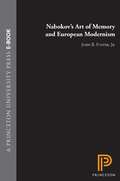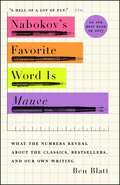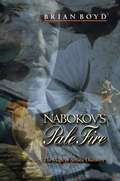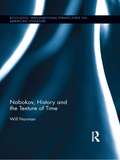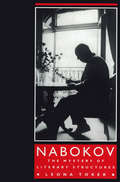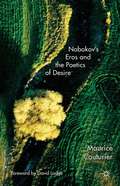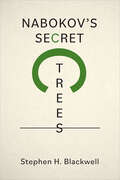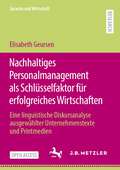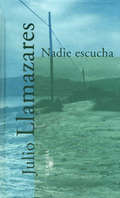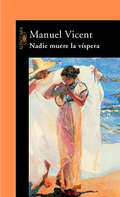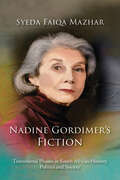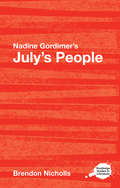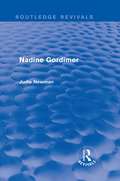- Table View
- List View
Nabokov's Art of Memory and European Modernism
by John Burt FosterDespite Vladimir Nabokov's hostility toward literary labels, he clearly recognized his own place in cultural history. In a fresh approach stressing Nabokov's European context, John Foster shows how this writer's art of memory intersects with early twentieth-century modernism. Tracing his interests in temporal perspective and the mnemonic image, in intertextual "reminiscences," and in individuality amid cultural multiplicity, the book begins with such early Russian novels as Mary, then treats his emerging art of memory from Laughter in the Dark to The Gift. After discussing the author's cultural repositioning in his first English novels, Foster turns to Nabokov's masterpiece as an artist of memory, the autobiography Speak, Memory, and ends with an epilogue on Pale Fire.As a cross-cultural overview of modernism, this book examines how Nabokov navigated among Proust and Bergson, Freud and Mann, and Joyce and Eliot. It also explores his response to Baudelaire and Nietzsche as theorists of modernity, and his sense of Dostoevsky, Tolstoy, and Pushkin as modernist precursors. As an approach to Nabokov, the book reflects the heightened importance of autobiography in current literary study. Other critical issues addressed include Bakhtin's theory of intertextuality, deconstructive views of memory, Benjamin's modernism of memory, and Nabokov's assumptions about modernism as a concept.
Nabokov's Favorite Word Is Mauve: What the Numbers Reveal About the Classics, Bestsellers, and Our Own Writing
by Ben BlattWhat are our favorite authors’ favorite words? Which bestselling writer uses the most clichés? How can we judge a book by its cover? Data meets literature in this playful and informative look at our favorite authors and their masterpieces. “A literary detective story: fast-paced, thought-provoking, and intriguing.” —Brian Christian, coauthor of Algorithms to Live ByThere’s a famous piece of writing advice—offered by Ernest Hemingway, Stephen King, and myriad writers in between—not to use -ly adverbs like “quickly” or “fitfully.” It sounds like solid advice, but can we actually test it? If we were to count all the -ly adverbs these authors used in their careers, do they follow their own advice compared to other celebrated authors? What’s more, do great books in general—the classics and the bestsellers—share this trait? In Nabokov’s Favorite Word Is Mauve, statistician and journalist Ben Blatt brings big data to the literary canon, exploring the wealth of fun findings that remain hidden in the works of the world’s greatest writers. He assembles a database of thousands of books and hundreds of millions of words, and starts asking the questions that have intrigued curious word nerds and book lovers for generations: What are our favorite authors’ favorite words? Do men and women write differently? Are bestsellers getting dumber over time? Which bestselling writer uses the most clichés? What makes a great opening sentence? How can we judge a book by its cover? And which writerly advice is worth following or ignoring? Blatt draws upon existing analysis techniques and invents some of his own. All of his investigations and experiments are original, conducted himself, and no math knowledge is needed to understand the results. Blatt breaks his findings down into lucid, humorous language and clear and compelling visuals. This eye-opening book will provide you with a new appreciation for your favorite authors and a fresh perspective on your own writing, illuminating both the patterns that hold great prose together and the brilliant flourishes that make it unforgettable.
Nabokov's Pale Fire: The Magic of Artistic Discovery
by Brian BoydPale Fire is regarded by many as Vladimir Nabokov's masterpiece. The novel has been hailed as one of the most striking early examples of postmodernism and has become a famous test case for theories about reading because of the apparent impossibility of deciding between several radically different interpretations. Does the book have two narrators, as it first appears, or one? How much is fantasy and how much is reality? Whose fantasy and whose reality are they? Brian Boyd, Nabokov's biographer and hitherto the foremost proponent of the idea that Pale Fire has one narrator, John Shade, now rejects this position and presents a new and startlingly different solution that will permanently shift the nature of critical debate on the novel. Boyd argues that the book does indeed have two narrators, Shade and Charles Kinbote, but reveals that Kinbote had some strange and highly surprising help in writing his sections. In light of this interpretation, Pale Fire now looks distinctly less postmodern--and more interesting than ever. In presenting his arguments, Boyd shows how Nabokov designed Pale Fire for readers to make surprising discoveries on a first reading and even more surprising discoveries on subsequent readings by following carefully prepared clues within the novel. Boyd leads the reader step-by-step through the book, gradually revealing the profound relationship between Nabokov's ethics, aesthetics, epistemology, and metaphysics. If Nabokov has generously planned the novel to be accessible on a first reading and yet to incorporate successive vistas of surprise, Boyd argues, it is because he thinks a deep generosity lies behind the inexhaustibility, complexity, and mystery of the world. Boyd also shows how Nabokov's interest in discovery springs in part from his work as a scientist and scholar, and draws comparisons between the processes of readerly and scientific discovery. This is a profound, provocative, and compelling reinterpretation of one of the greatest novels of the twentieth century.
Nabokov, History and the Texture of Time (Routledge Transnational Perspectives on American Literature)
by Will NormanThis book argues that the apparent evasion of history in Vladimir Nabokov’s fiction conceals a profound engagement with social, and therefore political, temporalities. While Nabokov scholarship has long assumed the same position as Nabokov himself — that his works exist in a state of historical exceptionalism — this study restores the content, context, and commentary to Nabokovian time by reading his American work alongside the violent upheavals of twentieth-century ideological conflicts in Europe and the United States. This approach explores how the author’s characteristic temporal manipulations and distortions function as a defensive dialectic against history, an attempt to salvage fiction for autonomous aesthetics. Tracing Nabokov’s understanding of the relationship between history and aesthetics from nineteenth-century Russia through European modernism to the postwar American academy, the book offers detailed contextualized readings of Nabokov’s major writings, exploring the tensions, fissures, and failures in Nabokov’s attempts to assert aesthetic control over historical time. In reading his response to the rise of totalitarianism, the Holocaust, and Cold War, Norman redresses the commonly-expressed admiration for Nabokov’s heroic resistance to history by suggesting the ethical, aesthetic, and political costs of reading and writing in its denial. This book offers a rethinking of Nabokov’s location in literary history, the ideological impulses which inform his fiction, and the importance of temporal aesthetics in negotiating the matrices of modernism.
Nabokov: The Mystery of Literary Structures
by Leona TokerVladimir Nabokov described the literature course he taught at Cornell as "a kind of detective investigation of the mystery of literary structures." Leona Toker here pursues a similar investigation of the enigmatic structures of Nabokov's own fiction. According to Toker, most previous critics stressed either Nabokov’s concern with form or the humanistic side of his works, but rarely if ever the two together. In sensitive and revealing readings of ten novels, Toker demonstrates that the need to reconcile the human element with aesthetic or metaphysical pursuits is a constant theme of Nabokov’s and that the tension between technique and content is itself a key to his fiction. Written with verve and precision, Toker’s book begins with Pnin and follows the circular pattern that is one of her subject’s own favored devices.
Nabokov’s Eros and the Poetics of Desire
by Maurice CouturierNabokov gained international fame with Lolita, a highly erotic and morally disturbing novel. Through its comprehensive study of the amorous and sexual behaviors of Nabokov's characters this book shows how Eros, both as a clown or a pervert, contributes to the poetic excellence of his novels and accounts for the unfolding of the plots.
Nabokov’s Secret Trees
by Stephen H. BlackwellIn nearly all his literary works, Vladimir Nabokov inscribed networks of trees to create meaningful patterns of significance around one or more of his passionate interests – in consciousness, memory, creativity, epistemology, ethics, and love, with a deep connection to nature serving as a constant undercurrent. Nabokov’s Secret Trees explores this neglected area of his art, one that positions nature as a hidden but vital core of his work. The book presents an entirely new, previously unsuspected Nabokov, one who crafts intricate patterns of arboreal imagery lurking behind his often-baroque psychological narratives. It reveals how Nabokov activates arboreal potentials by exploring the hidden ubiquity of trees, their essence as complex natural phenomena, and their role as quiet presences that have accompanied and fostered human civilization and art since their beginnings. The book uncovers how trees offer a rich and intricate field for structural, semantic, allusive, and metaphorical exploration. Based on the published corpus as well as archival materials, Nabokov’s Secret Trees demonstrates that trees not only populate Nabokov’s art in stunning, yet furtive, abundance, but also as mysterious natural entities, directly animating his works’ worlds and his readers’ experience of them.
Nachhaltiges Personalmanagement als Schlüsselfaktor für erfolgreiches Wirtschaften: Eine linguistische Diskursanalyse ausgewählter Unternehmenstexte und Printmedien (Sprache und Wirtschaft)
by Elisabeth GeursenMit diesem Open-Access-Buch liefert Elisabeth Geursen erstmals Erkenntnisse zum Nachhaltigkeitsbegriff im Personalmanagement, auf den mit „Human Capital“ oder „Human Ressource“ referiert wird, mithilfe primär linguistischer Methoden. Der Nachhaltigkeitsidee wird im deutschsprachigen und internationalen Kontext gesellschaftspolitische Relevanz zugewiesen. Geursen präsentiert im Bereich des gesellschaftlichen Diskurses um nachhaltiges Wirtschaften im Personalbereich prominente Themenkomplexe und deren diskurspezifische Verhandlung in ihrer zeitlichen Entwicklung über einen Zeitraum von 20 Jahren. Hervorzuheben ist der kontrastive Ansatz: Es wird die Themenentwicklung in den Geschäfts- und Nachhaltigkeitsberichten von drei branchenspezifischen Unternehmen, die hinsichtlich ihrer Nachhaltigkeitsaktivitäten besondere massenmediale Aufmerksamkeit erhalten, sowie in überregionalen Printmedien untersucht. Aus den Analyseergebnissen leitet Geursen Handlungsempfehlungen für Akteure ab und demonstriert damit einen starken Praxisbezug. Geursen gelingt eine Erweiterung bisheriger Nachhaltigkeitsforschung in einem wirtschaftswissenschaftlichen Themenfeld durch eine operationalisierte, theoretisch-fundierte diskurslinguistische und framebezogene Methodik (hier dem Verfahren nach Konerding entsprechend).
Nadie escucha (Alfaguara Ser.)
by Julio LlamazaresOpiniones, reportajes y artículos de viaje que revelan el pensamiento y la experiencia de un escritor que ha dado a la literatura española contemporánea algunas de sus mejores páginas. «Últimamente hay demasiado ruido. Si de alguna manera tuviera que definir la época en la que estamos viviendo, es como un tiempo en el que hay tanto ruido que nadie escucha a nadie, ni siquiera a sí mismo.» En medio de esta constatación escéptica, la prosa tranquila, amable y socarrona de Julio Llamazares resulta ser un lugar de descanso, un oasis ameno donde la palabra del autor se confunde con las reflexiones del lector, un regalo para todos aquellos capaces de escuchar a los demás sin dejar por ello de oírse a sí mismos. A esos lectores dedica el autor Nadie escucha.
Nadie muere la víspera
by Manuel VicentManuel Vicent recopila en Nadie muere en la víspera 150 textos sobre filosofía de vida y su profesión. «Este libro no es solo una selección de artículos que he escrito en El País a lo largo de los últimos cuatro años. De este trabajo ha sido extraído un núcleo de sensaciones, historias y visiones hasta formar un dietario, que puede leerse como una forma de ser, de pensar, de creer y de vivir: un trayecto hacia una salvación personal en la que cualquier lector puede participar. De todo lo que nos ocurre en este camino de la vida he tratado de escoger esos momentos que nos hacen felices, perplejos, escépticos y expertos en pequeños placeres. Las mismas palabras que fueron embarcadas en un periódico tienen ahora en el libro una lectura distinta y una trama nueva cuyo argumento es este: hasta el día de la muerte todos somos inmortales cazadores de mariposas.»Manuel Vicent
Nadine Gordimer's Fiction: Transitional Phases in South African History, Politics and Society
by Syeda Faiqa MazharNadine Gordimer’s Fiction is a major study of the life and writings of Nadine Gordimer, a towering figure in the literary and cultural life of South Africa in the late 20th and early 21st centuries, recognised for her fiction through several prizes, most notably the 1991 Nobel Prize for Literature. It has the makings of a guide, taking the reader through the complexities in Gordimer’s life, literature, and society, backed by academic research (doctoral and postdoctoral) and informed by Dr. Mazhar’s study visit to South Africa, including a face-to-face interview with Gordimer. The reader gets a rich picture mediated by the author’s own intellectual journey from Pakistan – the country of her birth – and the United Kingdom. Dr. Mazhar maps the complexities of colonialism in South Africa and beyond in different forms, most notably in the legislated discrimination based on race/ethnicity, Apartheid (1948–1994). Covering the literary writings and political activism of Gordimer both during and after Apartheid, the book provides the reader with a detailed account of individual works of fiction, and vistas of critical thought and action that serve as their source and backdrop. Dr. Mazhar draws on the cultural theories of Homi Bhabha, especially on the notion of The Third Space, a fictional space/borderland between social and political polarisations, which allows for reflection, refinement, and re-action that is transformational and psychologically uplifting. She demonstrates that Gordimer takes her characters through such spaces, which allow for a transformational experience that leads to perspectives/realisations that were missing as a result of constraints that were externally imposed by law and tradition and interiorised as a survival mode. Dr. Mazhar concludes that Gordimer gracefully articulates her vision for a world free of complexities, which one must strive for. Although the book presents the academic analysis of Gordimer‘s fiction and the memoir as separate parts, there are organic connections between the two, which link the social ethos, political struggles, varied ideological perspectives, and ethnic and trans-ethnic identities from which Gordimer draws her subjects and their lives and depicts them through appropriate narrative techniques. Nadine Gordimer’s Fiction is a welcome addition to books on author studies, literary criticism, and South African culture and society. It offers excellent material for both academic and non-academic readers. The style of writing used in the book is clear and simple, yet powerful. This can help the reader to appreciate the enormous achievement of Gordimer, which has established her as a major literary figure in South Africa and beyond. Dr. Balasubramanyam Chandramohan PhD (Shef), FHEA, Senior Research Fellow, Institute of Commonwealth Studies, School of Advanced Study, University of London
Nadine Gordimer's July's People: A Routledge Study Guide (Routledge Guides to Literature)
by Brendon NichollsNadine Gordimer is one of the most important writers to emerge in the twentieth century. Her anti-Apartheid novel July's People (1981) is a powerful example of resistance writing and continues even now to unsettle easy assumptions about issues of power, race, gender and identity. This guide to Gordimer's compelling novel offers: an accessible introduction to the text and contexts of July's People a critical history, surveying the many interpretations of the text from publication to the present a selection of new and reprinted critical essays on July's People, providing a range of perspectives on the novel and extending the coverage of key approaches identified in the critical survey cross-references between sections of the guide, in order to suggest links between texts, contexts and criticism suggestions for further reading. Part of the Routledge Guides to Literature series, this volume is essential reading for all those beginning detailed study of July's People and seeking not only a guide to the novel, but a way through the wealth of contextual and critical material that surrounds Gordimer's text.
Nadine Gordimer: A Casebook (Routledge Revivals)
by Judie NewmanInternational in her appeal, Nadine Gordimer is an original and accomplished novelist whose works have found literary and popular recognition. In this critical study, first published in 1988 and the first by a woman, Judie Newman discusses Gordimer’s novels, including A Sport of Nature. Gordimer’s writing is both political committed and formally innovative, confronting subject matter of great contemporary interest and at the same time seeking out narrative forms that combine European and indigenous culture. Her novels are sensitive to their context, while also offering an important contribution to postmodernist reassessments of narrative poetics, and a challenge to European conceptions of the novel. Judie Newman places particular emphasis on Gordimer’s searching investigation of the relation of gender to genre, and explores other major concerns such as the crisis of liberal values, the nature of historical consciousness, racism, sexual politics, and the psychopathology of power. Her study combines close literary analysis with a wide-ranging exploration of ideas, showing clearly how the artist can contribute to contemporary debate.
Nafssiya, or Edward Said's Affective Phenomenology of Racism
by Norman Saadi NikroThis book adapts the Arabic term nafsiyya to trace the phenomenological contours of Edward Said’s analysis of the affective dimensions of colonial and imperial racism. Reflecting on what he called his “colonial education,” Said rendered his Palestinian/Arab background and experience of racism an enabling component of his academic work. The argument focuses on his “personal dimension” section in his introduction to his famous volume Orientalism, discussing key notions of Said’s oeuvre—such as ‘elaboration,’ ‘circumstance,’ ‘humanism,’ ‘worldliness,’ ‘inventory,’ and ‘critical consciousness.’ Providing a lengthy study of his earlier and somewhat neglected Beginnings: Intention and Method, the book discusses the significance of the style of the essay as a key component of what the author calls Said’s interventionist brand of scholarship. The final chapter outlines how Said’s oeuvre can be situated in a genealogy of a radical phenomenology of racism that emerged from the colonies.
Nagai Kafū's Occidentalism: Defining the Japanese Self
by Rachael HutchinsonNagai Kafū (1879–1959) spent more time abroad than any other writer of his generation, firing the Japanese imagination with his visions of America and France. Applying the theoretical framework of Occidentalism to Japanese literature, Rachael Hutchinson explores Kafū's construction of the Western Other, an integral part of his critique of Meiji civilization. Through contrast with the Western Other, Kafū was able to solve the dilemma that so plagued Japanese intellectuals—how to modernize and yet retain an authentic Japanese identity in the modern world. Kafū's flexible positioning of imagined spaces like the "West" and the "Orient" ultimately led him to a definition of the Japanese Self. Hutchinson analyzes the wide range of Kafū's work, particularly those novels and stories reflecting Kafū's time in the West and the return to Japan, most unknown to Western readers and a number unavailable in English, along with his better-known depictions of Edo's demimonde. Kafū's place in Japan's intellectual history and his influence on other writers are also discussed.
Naguib Mahfouz: The Pursuit of Meaning (Arabic Thought and Culture)
by Rasheed El-EnanyFirst Published in 2004. Routledge is an imprint of Taylor & Francis, an informa company.
Naked Edge: I-Team 4 (I-Team #4)
by Pamela ClareFans of Suzanne Brockmann, Maya Banks, Christy Reece, Julie Ann Walker and Cindy Gerard will adore Pamela Clare's expertly plotted romantic suspense series, which sets the pages alight with sizzling chemistry. For tension, thrills, romance and passion take a spin with the I-Team.The day Navajo journalist Katherine James met Gabriel Rossiter, the earth literally moved beneath her feet when he saved her from a rockslide. So she is crushed when she recognizes her rescuer among the law enforcement officers throwing her and her friends off Mesa Butte, land they consider sacred. Gabe swore he would never again lose himself to a woman. But the attraction he feels to Kat is undeniable. And, appalled by his orders, he's determined to get to the bottom of events at Mesa Butte. But asking questions can be dangerous - almost as dangerous as risking one's heart. Soon Kat and Gabe's passion for the truth - and each other - makes them targets for those who would do anything, even kill, to keep Native Americans off their sacred land...Sexy. Thrilling. Unputdownable. Take a wildly romantic ride with Pamela Clare's I-Team: Extreme Exposure, Hard Evidence, Unlawful Contact, Naked Edge, Breaking Point, Striking Distance.
Naked In Baghdad
by Anne GarrelsAs National Public Radio's senior foreign correspondent, Anne Garrels has covered conflicts in Chechnya, Bosnia, Kosovo, Afghanistan, and elsewhere. She is renowned for direct, down-to-earth, insightful reportage, and for her independent take on what she sees. One of only sixteen non-embedded American journalists who stayed in Baghdad's now-legendary Palestine Hotel throughout the American invasion of Iraq, she was at the very center of the storm. Naked in Baghdad gives us the sights, sounds, and smells of our latest war with unparalleled vividness and immediacy. Garrels's narrative starts with several trips she made to Baghdad before the war, beginning in October 2002. At its heart is her evolving relationship with her Iraqi driver/minder, Amer, who becomes her friend and confidant, often serving as her eyes and ears among the populace and taking her where no other reporter was able to penetrate. Amer's own strong reactions and personal dilemma provide a trenchant counterpoint to daily events. The story is also punctuated by e-mail bulletins sent by Garrels's husband, Vint Lawrence, to their friends around the world, giving a private view of the rough-and-tumble, often dangerous life of a foreign correspondent, along with some much-needed comic relief.
Naked Liberty and the World of Desire: Elements of Anarchism in the Work of D.H. Lawrence (Studies in Major Literary Authors #20)
by Simon CaseyIn this new and original study, Simon Casey explores the long-neglected link between D. H. Lawrence and philosophical anarchism. Focusing on the writings of some of the major anarchists-with particular emphasis on Stirner, Godwin, Bakunin and Thoreau-this book argues that the conceptual parallels between Lawrence and anarchism are strong and extensive and that reading Lawrence within the context of this tradition significantly enhances any understanding of his work. Lawrence's faith in the essential decency of human nature, his forceful defense of individual liberty, and his intolerance of all forms of domination and control all reflect the essential features of anarchism. Naked Liberty and the World of Desire looks at where these attitudes find explicit articulation in Lawrence's essays, poems, and letters, and shows how they are illustrated in his major works of fiction.
Naked Lunch
by William S. BurroughsDelirious, nonlinear ravings of a junkie in hell. Also includes excerpts from the Boston trial where it was declared not obscene in 1966.
Naked Playwriting: The Art, the Craft, and the Life Laid Bare
by William Missouri Downs Robin U. RussinOffers a playwriting course, from developing a theme through plotting and structuring a play, developing characters, creating dialog, formatting the script, and applying methods that aid the actual writing and rewriting processes. This book also provides guidance on marketing and submitting play scripts for both contests and production.
Name Me a Word: Indian Writers Reflect on Writing
by Meena AlexanderA wide-ranging anthology of twentieth-century and contemporary writing from India and the Indian diaspora, curated by a distinguished scholar and poet Internationally renowned scholar, poet, and essayist Meena Alexander brings together leading twentieth- and twenty-first-century voices from India and the diaspora in this anthology. Contributors include English-language luminaries such as R. K. Narayan, Salman Rushdie, and Arundhati Roy and powerful writers in Indian languages such as U. R. Ananthamurthy, Mahasweta Devi, and Lalithambika Antherjanam. This book will make a thoughtful gift for poetry and fiction enthusiasts and fans of Indian literature, as well as an ideal volume for academics introducing writers from the subcontinent.
Name that Feeling: A Turn-and-See Book (What's Next?)
by Cari MeisterLightning flashes. Thunder rumbles. It’s a big storm! How do you think Micah feels? Woof! Woof! Gemma’s grandma brought her a puppy. How do you think Gemma feels? Turn the page to find out which feeling matches the description. Would you feel the same way?
Names Of Christ (Names of... Series)
by Charles E. Hurlburt T. C. HortonLily of the Valley. Bright and Morning Star. Rose of Sharon. Author of the Faith. The Lord Jehovah. Friend of Sinners. Son of Man. King of Kings.What does Christ mean to you? When you consider His person, His work, and His words, are you struck by the depth and complexity, the richness and incalculable beauty of who He is? This classic study, revised for today's reader, examines the many names of Christ, more than 300 in all, each revealing an intimate portrait of the Savior. In this new edition, devotional prayers accompany each name, helping you meditate on the character and person of Jesus Christ. This book is an invaluable resource to any library and is sure to enrich your personal devotional time. Names of Christ follows Names of God in a classic trilogy designed to help contemporary Christians better understand the glory, majesty, and power of the triune God.
Names Of Christ (Names of... Series)
by Charles E. Hurlburt T. C. HortonLily of the Valley. Bright and Morning Star. Rose of Sharon. Author of the Faith. The Lord Jehovah. Friend of Sinners. Son of Man. King of Kings.What does Christ mean to you? When you consider His person, His work, and His words, are you struck by the depth and complexity, the richness and incalculable beauty of who He is? This classic study, revised for today's reader, examines the many names of Christ, more than 300 in all, each revealing an intimate portrait of the Savior. In this new edition, devotional prayers accompany each name, helping you meditate on the character and person of Jesus Christ. This book is an invaluable resource to any library and is sure to enrich your personal devotional time. Names of Christ follows Names of God in a classic trilogy designed to help contemporary Christians better understand the glory, majesty, and power of the triune God.
